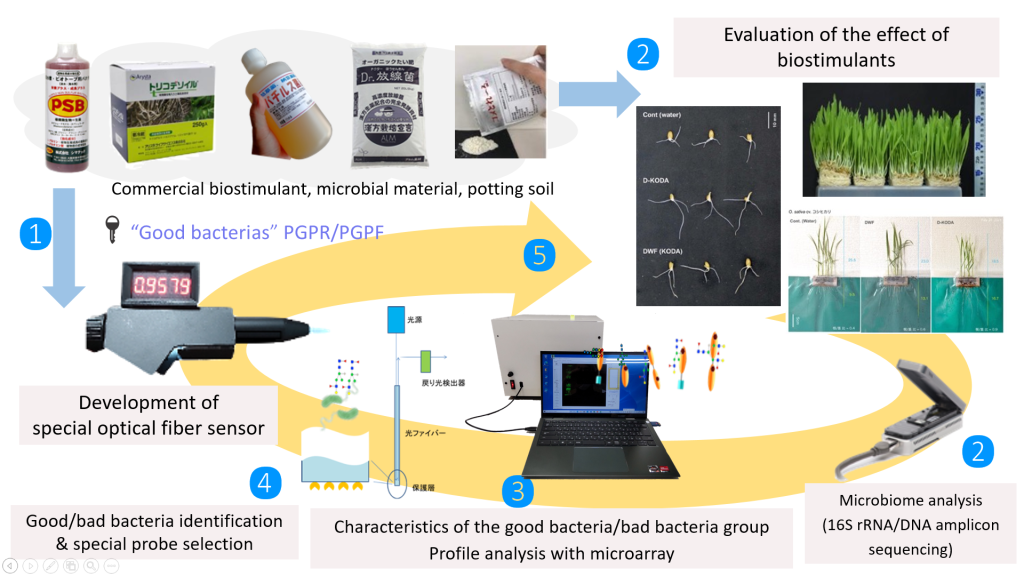Tomohiro Ban (Professor, Kihara Institute for Biological Research, Yokohama City University) and Masao Yamada (Representative of Mx) teamed up to launch the team AgroHolobiont to realize the global issue of regenerative and sustainable agriculture. This was the beginning of this issue, how realize environmentally regenerative and sustainable agriculture.
Due to climate change on a global scale, some places are undergoing desertification, others are suffering from flooding, and rising sea levels are exacerbating salinity damage. As the world’s population increases, the demand for chemical fertilizers, which are used to increase food production, is on the rise. The war between Russia and Ukraine has stagnated exports from one of the world’s leading fertilizer exporters. Because of the unbalance between demand and supply, fertilizer prices are soring rapidly. Indeed, the world is about to face an unprecedented food crisis. Our purpose is to save the world’s food crisis by realizing regenerative and sustainable agriculture.
Going back a little in the history of the world’s food supply, there was a period from the 1940s to the 1960s called the “Green Revolution,” a period of great change that increased the efficiency of agricultural production. However, only 30% of the large amount of chemical fertilizers are actually absorbed by plants, and most of it flows out into the environment, causing air and river pollution, acid rain, global warming, the loss of cultivated soil, and the loss of biodiversity. Green Revolution unexpectedly become a catalyst for environmental problems on a global scale. Of course, today’s global environmental problems are closely related to energy problems, and the Green Revolution is not the only one to blame. It is said that agriculture accounts for 1/4 of CO2 emissions.
Therefore, a “New Green Revolution” is necessary to fundamentally solve this problem. What is the new green revolution? It is to create a recycling-type food production system by stopping the conventional large-scale application of chemical fertilizers and chemical pesticides and by realizing fertile soil. By advancing the new green revolution, carbon fixation will advance. In other words, CO2 in the atmosphere, which causes global warming, is taken up from the leaves of plants and carbon is fixed as carbohydrates such as glucose through photosynthesis. Carbohydrates synthesized by plants are circulated to the soil as secretions from the roots (transformed into sugars and organic matter). These secretions promote the growth of microorganisms present in the soil, and as a result, the nitrogen fixation, which is the source of the amino acids necessary for plants, progresses, and the solubilization of nutrients (phosphorus and potassium) in the soil progresses, leading to the effective use of fertilizers. Furthermore, beneficial bacteria in the rhizosphere expand their territory and secrete antibacterial substances, which suppress plant pathogens, and plant growth hormones as metabolites, which promotes plant growth. And further, we must not forget the aspect that biofilms secreted by rhizospheric microorganisms make plants resistant to drought due to their high water-holding capacity.
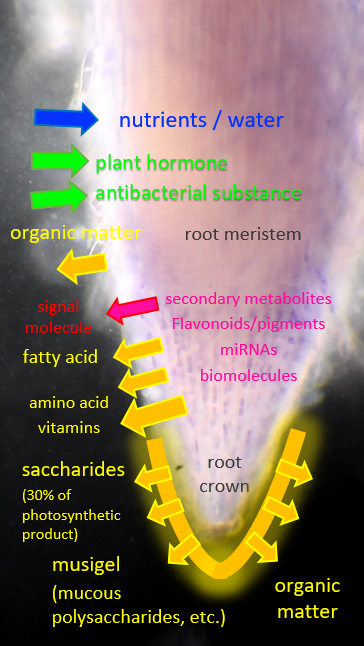
Thus, a fertile soil is the one in which there exists a rich symbiotic relationship between microorganisms and plants. Conventional agriculture focuses too much on managing soil physical aspects such as drainage, water retention, and air permeability, and chemical aspects such as pH and the balance of fertilizer components. But, biological aspects are poorly controlled.
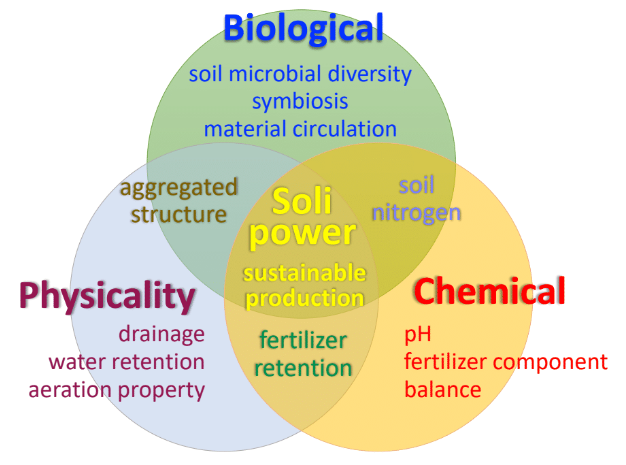
The presence of diverse rhizosphere bacteria is proof of the robustness of the soil, making it resistant to environmental changes. Plant root secretions vary from plant to plant, and also vary even between domesticated and wild types of the same plant species. These genetic differences in plants affect the composition of the rhizospheric microbiota, which is further altered by the soil environment. Therefore, the fertile soil for plants is not uniform, and the ultimate “new green revolution” is to induce the optimum rhizospheric microbiota for individual plants.
As a general trend, the so-called beneficial bacteria for plants include Pseudomonus, Bacillus, Enterobacter, Serratia, Oxalobacteria, Streptomyces, and Arthrobacter. Beneficial fungi for plants include Gromus, Gigaspore, Rhizophagus , Rhizopus, Rhizoctonia, Tricoderma, and Streptomyces.
The rhizospheric microbiota, like the intestinal microbiota, contains a huge number of types of bacteria. Since the rhizospheric microbiota is a typical kind of complex system, the quickest way is to do feature extraction of such a complex system. At the research site, through comprehensive 16S rRNA read analysis of rhizospheric microbiota and computer analysis on the big data obtained could be used to expose and visualize hidden characteristic patterns in the complex system. However, the cost and the required analysis time are huge. Can such a method be used in the field? No, If the technology is not easy for anyone to use, it will not succeed as a business. It has to be cheap technology that anyone can use, and it has to give immediate results. Focusing on this point, Mx (emukk) has developed a “ultra cheap, fast, high sensitive, and easy to use” optic biome sensor (OBS). By the way, the physical size of OBS is the size of a smartphone.
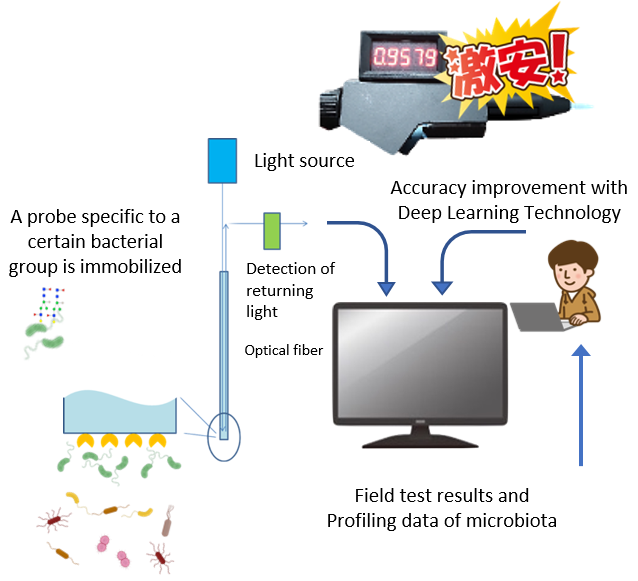
The prototype OBS uses groundbreaking technologies to reduce manufacturing costs to the US$35.00 level. We have already applied for this basic patent on September 14th, 2022 (patent application No. 2022-146003 in Japan). This sensor is not a cheap or bad one as imagined from the cost. Although various optical fiber type sensors have been developed so far, the performance of OBS is by no means inferior to them. This is the result of aggressive reduction in the number of parts and a high sensitivity technology achieved by devising the optical system.
Below is an example of measuring Bacillus, which is a typical beneficial bacteria in the rhizosphere, using the OBS prototype sensor. The numbers on the vertical axis indicate the signal intensity (mV) of the return light obtained by converting the current of the photodetector into voltage with a transimpedance amplifier. When the sensor end face of the optical fiber is immersed in the bacillus solution, the signal begins to rise linearly and reaches the saturation point after 15 minutes. As shown in this example, this OBS is extremely cheap, but it can properly capture the target object, and it can be measured in a short time of 15 minutes. By the way, the sample solution does not require any pretreatment, and therefore anyone can use it easily. By changing the probe immobilized on the end face of the optical fiber sensor, it is possible to capture different bacterial species, and the second prototype of OBS is designed so that the optical fiber sensor can be easily replaced. Thus, OBS could recognize beneficial bacteria in rhizosphere like a thermometer. A microbiome sensor used for detecting rhizospheric optic biome will be abbreviated as “rOBS”
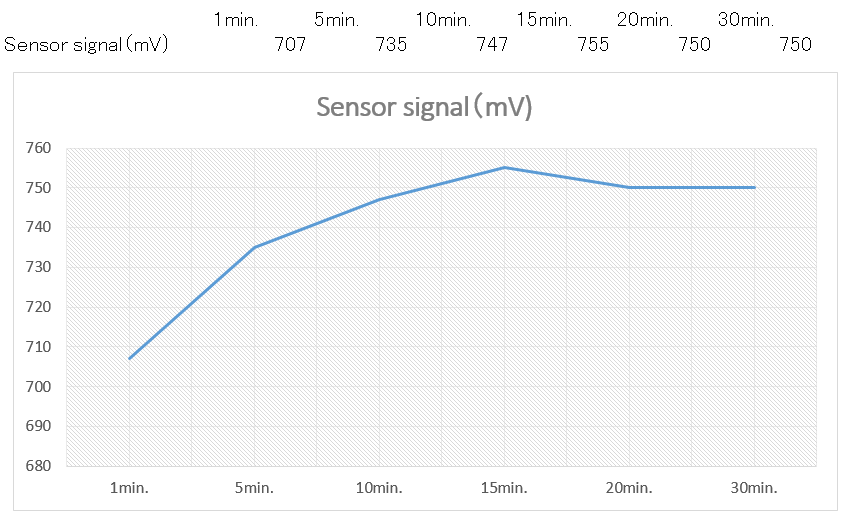
Now, the next question is how to control the rhizospheric microbiota?. The answer is to use biostimulants for that. Biostimulants themselves have been around for a long time, with a variety of products that promote plant growth or make plants more resistant to disease. The effect of each biostimulant is different, but as a typical example, the biostimulant of duckweed fermented compost is known to induce beneficial bacteria. The figure below shows that the beneficial bacteria thereby induced exert an antibacterial effect against Fusarium, a plant pathogenic fungus.
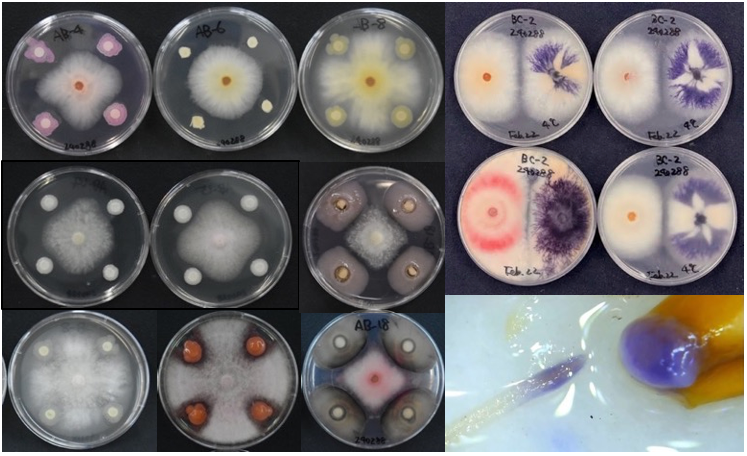
Here you may be wondering. “If biostimulants have been around for so long, why aren’t they being used more?” This is because the rhizospheric microbiota is not uniform, and it is affected by various factors such as plant species, genetic traits, and environments, whether the plant is monocropped or intercropped. Let’s remember when a human got sick and went to the hospital. A doctor will perform various checks to determine the cause of the disease, and then issue the best prescription. Then, looking at the progress, re-examine if necessary, and change the prescription. It’s the same with the rhizosphere. If you apply a biostimulant without even investigating the state of the rhizospheric microbiota, it may work in some cases but will not work in others. This is because you are prescribing without knowing the characteristics of rhizospheric microbiota. The reason why it did not wok may be just a dose problem, or you may applied the wrong biostimulant against the target.
The “New Green Revolution” is only possible when optic biome sensors and biostimulants come together. In this way, we are steadily accumulating practical achievements to achieve the goal of becoming the leader of the “New Green Revolution” three years from now.
